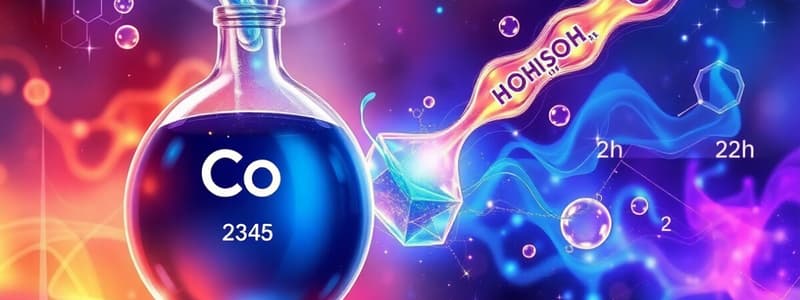Podcast
Questions and Answers
Which of the following processes is endothermic?
Which of the following processes is endothermic?
- Deposition
- Freezing
- Condensation
- Sublimation (correct)
What is the correct number of significant figures in the result of the following calculation: $12.34 + 5.678$?
What is the correct number of significant figures in the result of the following calculation: $12.34 + 5.678$?
- 6
- 3
- 5
- 4 (correct)
Which of the following pairs of elements are isotopes?
Which of the following pairs of elements are isotopes?
- Carbon-12 and Oxygen-16
- Carbon-12 and Carbon-14 (correct)
- Hydrogen-1 and Deuterium (Hydrogen-2)
- Sodium-23 and Chlorine-35
Which of the following is the correct name for the ionic compound formed between potassium (K) and bromine (Br)?
Which of the following is the correct name for the ionic compound formed between potassium (K) and bromine (Br)?
What is the empirical formula for a compound that contains 40.0% carbon, 6.7% hydrogen, and 53.3% oxygen by mass?
What is the empirical formula for a compound that contains 40.0% carbon, 6.7% hydrogen, and 53.3% oxygen by mass?
How many moles of sodium chloride (NaCl) are present in 58.44 g of NaCl? (Molar mass of NaCl = 58.44 g/mol)
How many moles of sodium chloride (NaCl) are present in 58.44 g of NaCl? (Molar mass of NaCl = 58.44 g/mol)
Which of the following is the correct formula for sulfuric acid?
Which of the following is the correct formula for sulfuric acid?
Flashcards
Element vs. Compound
Element vs. Compound
An elemental substance consists of one type of atom; a compound comprises two or more different atoms chemically bonded.
Ionic vs. Molecular Compounds
Ionic vs. Molecular Compounds
Ionic compounds are formed from the transfer of electrons, typically between metals and nonmetals; molecular compounds consist of molecules formed by sharing electrons.
Endothermic vs. Exothermic
Endothermic vs. Exothermic
Endothermic processes absorb heat (e.g., melting); exothermic processes release heat (e.g., freezing).
Extensive vs. Intensive Properties
Extensive vs. Intensive Properties
Signup and view all the flashcards
Significant Figures
Significant Figures
Signup and view all the flashcards
Density Formula
Density Formula
Signup and view all the flashcards
Conversion of Units
Conversion of Units
Signup and view all the flashcards
Calculating Average
Calculating Average
Signup and view all the flashcards
Study Notes
Exam 1 Review - Spring 2025
- Distinguish pure elemental substances, pure compounds, heterogeneous mixtures, and homogeneous mixtures using drawings.
- Differentiate between ionic and molecular compounds through drawings.
- Identify separation methods for various mixtures.
- Differentiate between chemical and physical properties.
- List all endothermic phase changes (sublimation, fusion/melting, vaporization).
- List all exothermic phase changes (deposition, freezing, condensation).
- Define extensive and intensive properties.
- Understand metric prefixes and their conversion factors.
- Apply significant figure rules for calculations.
- Calculate simple averages and assess measurement accuracy and precision.
- Convert between Kelvin and Celsius scales.
- Calculate density (D = mass/volume) and relate mass, volume, and density.
- Determine uncertainty and use correct significant figures in measurements.
- Solve dimensional analysis problems.
- Relate periodic table families and periods to element properties.
- Recall names of groups on the periodic table.
- Recognize historically significant scientists responsible for developing atomic structure models.
- Calculate the percent composition of an element in a compound.
- Identify the number of protons, neutrons, and electrons in isotopes and ions.
- Determine the average atomic mass of an element based on isotopic masses and relative abundance.
- Determine if elements are isotopes.
- Distinguish between molecular and ionic compounds.
- Determine empirical formulas.
- Name ionic and molecular compounds. (Activity in class/video to follow)
- Convert grams to moles (division by molar mass)
- Convert moles to grams (multiplication by molar mass)
- Convert moles to molecules/atoms (multiplication by Avogadro's number)
- Convert atoms/molecules to grams of an element (division by Avogadro's Number)
- Additional video content will be available by Thursday to cover material.
Studying That Suits You
Use AI to generate personalized quizzes and flashcards to suit your learning preferences.




